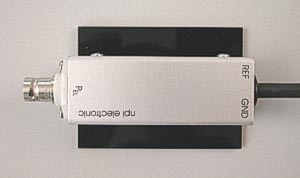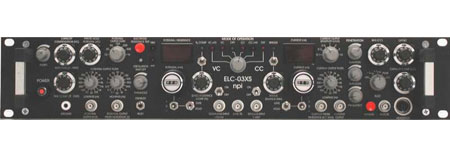ELC-03XS
The ELC-03XS amplifier is the only commercially available amplifier that is not only designed for the loose-patch clamp technique for recording in slice or in vivo preparations, but also for a wide range of other electrophysiological experiments. This amplifier enables an investigator to identify a single cell in a preparation by its characteristic spike train, then inject dye, electroporate or stimulate this cell in situ. The unique ELC headstage that meets these diverse experimental requirements incorporates a resistive-feedback circuit capable of functioning as a patch clamp headstage with pA sensitivity, or as a high-impedance electrometer with bridge balance capable of functioning as a conventional bridge amplifier, or as an extracellular amplifier with differential input for sensitive measurement of field potentials or single-unit activity. The ELC-03XS amplifier offers an unprecedented combination of capabilities and is much better suited for experiments requiring multiple electrical recording or stimulation protocols than other commercial amplifiers that are designed specifically to perform only a single function. Investigators with more limited equipment budgets will also be pleased by the reasonable cost of this versatile instrument. The ELC amplifier combines the traditional approaches of electrical measurements, electrical stimulation and dye application with new approaches that make possible experiments under more natural, i.e. non-invasive conditions, with minimal damage to sensitive preparations, even on the level of individual cells or subcellular structures such as dendrites and axons.

ELC Headstage
The system includes a voltage clamp mode for approaching cells and a current clamp mode for recording. In current clamp mode a bridge balance cancels electrode artifacts, and a current pump allows electroporetic dye injection or transfection, if required in VCx10 or CCx10 mode. Two digital displays, an audio monitor, an electrode resistance test and other functions make these amplifiers ideal for extracellular loose-patch experiments. Additional features are ten-turn controls for BRIDGE balance (CC) and RS COMPENSATION (VC in patch clamp), Low-pass Bessel filters for current and potential outputs, highpass filter and variable gain on potential output for extracellular recording. An oscillation shut off unit and tunable penetration help complete this instrument.
The ELC amplifier is also available as module (ELC-03M) for the EPMS-07 system.
Specifications
HEADSTAGE:
Input voltage range: ±1000 mV, other ranges possible
Operating voltage: ±15 V
Enclosure: Size: 23 × 70 × 26 mm, grounded
Mounting plate: Size: 68 mm × 54 mm
On request:
Holding bar: length 150 mm, O.D. 8 mm
Electrode connector: BNC with driven shield
Ground connector: 2.4 mm connector
Input resistance: >1013 Ω (internally adjustable)
Current range: ±12 nA into 100 MΩ, other ranges possible
ELECTRODE PARAMETER CONTROLS:
OFFSET: range ±100 mV, ten-turn control
CAPACITY COMPENSATION: range 0 - 30 pF, ten-turn control
BIAS (internal adjustment): range ±100 pA, current adjustable with trim potentiometer
BRIDGE BALANCE:
0-100 MΩ (0-1000 MΩ possible): Adjustable with ten-turn control
ELECTRODE RESISTANCE TEST:
Sensitivity 100 mV / MΩ application of square current pulses ±1 nA
Display: 3 ½ digits, XXX MΩ, activated by push-button (same as POTENTIAL display)
BANDWIDTH AND SPEED RESPONSE:
Full power bandwidth (REL = 0): >30 kHz, rise time (10 % - 90 %)
DIGITAL DISPLAYS:
Display mV / MΩ: 3 ½ digits, XXXX mV or XXX.X MΩ
Display current: 3 ½ digits, XX.XX nA
POWER REQUIREMENTS:
115/230 V AC, 25 W (0.4 A/0.2 A fuse, SLOW).
DIMENSIONS/ WEIGHT:
19" rackmount cabinet
W 483 mm, H 250 mm, D 88 mm
4.5 kg
OUTPUTS:
Output impedance: 50 Ω
Max. voltage: ±12 V
Current output: BNC connector, sensitivity 0.1...10 V/nA,
Current output sensitivity: Rotary switch, 0.1, 0.2, 0.5, 1, 2, 5, 10 V/nA
Current display: 3 ½ digits, XX.XX nA, resolution 10 pA
Current LP filter: 4-pole BESSEL filter (other options available)
attenuation: -24 dB/octave,
corner frequencies (Hz): 20, 50, 100, 200, 300, 500, 700, 1k, 1,3k, 2k, 3k, 5k, 8k, 10k, 13k, 20k
Potential output ×1: BNC connector, sensitivity 1 V/V
Potential output: BNC connector, sensitivity 10...1k V/V
Potential output gain: Rotary switch, 10, 20, 50, 100, 200, 500, 1k
Potential LP filter: 4-pole BESSEL filter (other options available)
attenuation: -24 dB/octave,
corner frequencies (Hz): 20, 50, 100, 200, 300, 500, 700, 1k, 1,3k, 2k, 3k, 5k, 8k, 10k, 13k, 20k
Potential HP filter: 1-pole BESSEL filter (other options available)
attenuation: -6 dB/octave,
corner frequencies (Hz): DC, 0.1, 0.3, 0.5, 1, 3, 5, 10, 30, 50, 100, 300, 500, 800, 1k, 3k
Telegraph potential LP filter -8…+7 V, 1V/step
Telegraph potential HP filter -8…+7 V, 1V/step
Telegraph current filter -8…+7 V, 1V/step
Telegraph potential output sensitivity +1…+7 V, 1 V/step
Telegraph current output sensitivity +1…+7 V, 1 V/step
INPUTS:
Input impedance analog 100 kΩ
Input range ±12 V
Input impedance digital (TTL) 10 kΩ
Input range TTL 0-5 V
Current stimulus input CC via BNC connectors, sensitivity 1 nA / V
Current stimulus input CC×10 via BNC connectors, sensitivity 10 nA / V
Step gate input via BNC connector (TTL)
Gated stimulus CC with ten-turn control of holding current
resolution: 10 pA, range: ±10 nA
Gated stimulus CC×10 with ten-turn control of holding current
resolution: 100 pA, range: ±100 nA
Polarity selectable with toggle switch
Voltage command input VC via BNC connectors, sensitivity: /10 mV
Voltage command input VC×10 via BNC connectors, sensitivity: /1 mV
Step gate input via BNC connector (TTL)
Gated stimulus VC with ten-turn control of holding potential
resolution: 1 mV, range: ±1 V
Gated stimulus VC×10 with ten-turn control of holding potential
resolution: 10 mV, range: ±10 V
Polarity selectable with toggle switch





